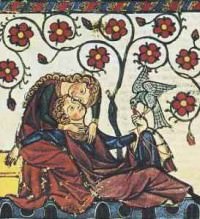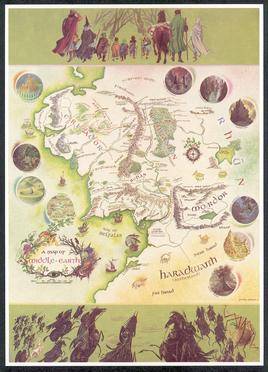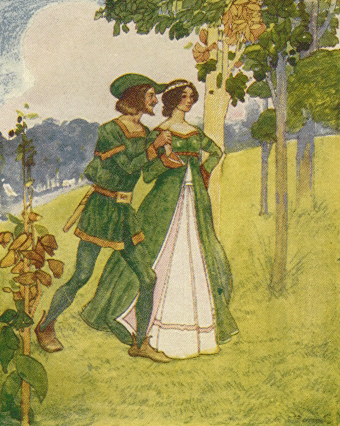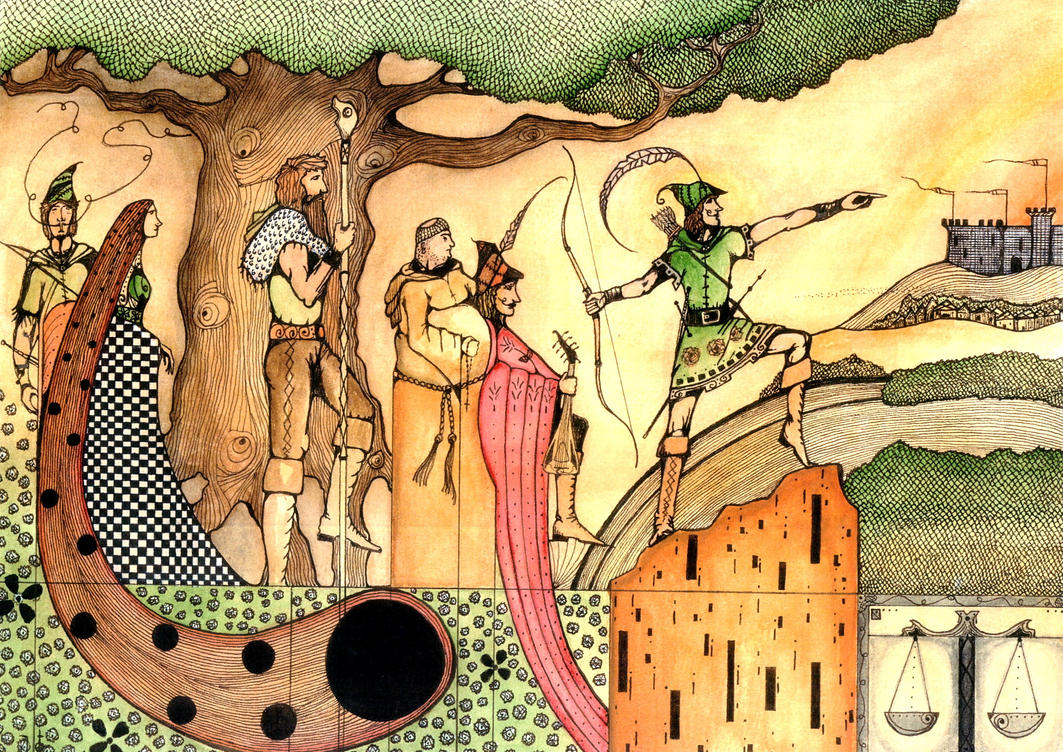It's almost Halloween! To celebrate, here is the first in a two part series looking at the evolution of late medieval and renaissance perceptions of witches, which is one of my favorite subjects. Enjoy!
In the midst of the medieval world
was a growing fear of harmful magic that would soon lead to the massive
execution and torture of men and women accused of witchcraft. Yet magic, both
its helpful remedies and harmful effects was nothing new to the late medieval
society. With the recovery of ancient texts on magic, the spread of the
printing, and earlier medieval literature, the idea of magic and witchcraft
during the late middle ages stood on a strong foundation of past works. Although
changing political and religious spheres undoubtedly played a role in helping
shape the idea of witchcraft, the literature and art circulating in the Renaissance
became an integral part of society, both reflecting and shaping the perception
of witchcraft.
With the Renaissance era as a time
of intellectual and artistic innovation and brilliance, the predominant belief
in what can now be seen as superstitious, almost stands in a stark contrast.
Yet, as historian Joseph Klaits notes, it is perhaps this very culture that was
ripe for a formation of the witch phenomenon, stating that the rediscovery of
ancient works on magic, as well as an idea of practical magic “produced an
environment favorable to the crystallization of the witch stereotype.” [1]With
literature serving to both reflect and influence society, using it as a focal
point can help illuminate this environment.
Thus it is to these earlier works,
that we must turn in order to uncover the evolving medieval attitudes towards
magic and witchcraft. Early literature of the Middle Ages that involved magic
often associated it with the courtly values of romance and chivalry. In early
romance fictions such as those of Marie de France and Chrétien de Troyes, magic
serves a multitude of purposes, as at times it is invoked to help heal a
wounded knight, while in others, it serves as a challenge. In Marie de France's
Guigemar, for instance, Guigemar is bestowed a magical wound in which he
can “never find a cure, nor may any herb, root, doctor, or potion ever heal.” [2] It
is only until he falls into the hands of a lady in which he is healed as she
brings “water in golden basins, washed his wounded thigh, then removed the
surrounding blood with a fine piece of white linen and bound it tightly.”[3]
It is with her loving care that he is able to be healed, and thus Guigemar
demonstrates magic being used to both inflict harm upon someone, as well as a
healing agent. Though seemingly disconnected from the ideas of witchcraft, this
early work provides an excellent example of how magic in a fictional setting
mirrored the realities of society. A 15th century document found in
the Wolsthurn Castle shows how the idea of curing someone with magic was not
only accepted, but actually practiced. Scholar Richard Kieckhefer gives the
following description of the handbook:
It contains instructions for almost every aspect of running
a household. It tells how to prepare leather, make soap or ink, wash clothes,
or catch fish...the compiler tells how to diagnose and treat fevers, ailments
of the eyes, and other medical problems...the book at hand contains elements we
can call magic. It recommends taking the leaves of a particular plant as a
remedy for ' fever of all sorts. [4]
Although Keickhefer points out that this particular remedy
would “count as science” and that the inclusion of writing Latin words on the leaves
would “count as religion,” he goes on to argue how these sort of procedures may
actually be a sort of magic, stating that “magic enters in with the notion that
the disease itself has a kind of personality and can respond to a command.” [5]
Thus it is clear how magical remedies portrayed in stories, even those as early
as the 12th century story of Guigemar could have been both a
reflection of what was attempting to be done in reality, as well as an
influential source for the practical use of magic.
Earlier ideas of magic, therefore,
provide a fascinating link to the opinion of magic circulating in the 14th
and 15th centuries in Europe, which placed magic not in the court,
but in the hands of a harmful witch. Literature and art played an important
role of this transition, as it slowly began depicting the ideas of demonic
magic and necromancy that would eventually become attributed to witchcraft.[6]
Wirnt von Gravenberg's Arthurian romance, Wigalois,[7]
tells the tale of Gawain's son who, through a series of challenges must seek
out and prove his worth to his father. One such challenge arises in the form of
a demonic magician and results in what scholar James Schultz describes as a
“lengthy and explicit contest between demonic magic and divine providence
[which] can be found in Arthurian romance only in Wigalois.”[8]
The story of Wigalois, and its inclusion of a magician who has explicit
connections with the devil, stands as an excellent example of the demonic ideas
that were beginning to become an integral part of literature and society. As a
13th century Arthurian tale, Wigalois stands as a sort of
bridge between how magic had been treated in the past Arthurian tales of
Chrétien de Troyes and Marie de France and the upcoming demonic magic
associated with witchcraft.
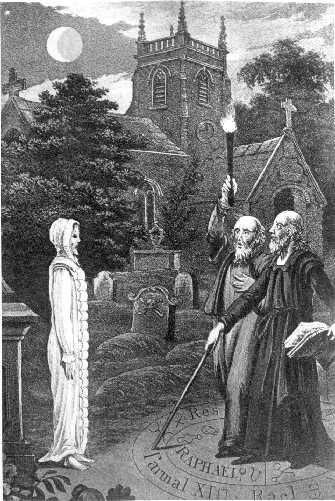 |
| An image similar to Necromancy's Messenger |
With the role of magicians changing
to include the aid of demons, a growing concern and practice of necromancy soon
found its way into the early Renaissance. Although medieval magic certainly did
not lack a dark or sinister side to it, the art of necromancy dramatically
shifted from medieval magic as it included the conjuring of spirits or demons in
order to create illusions, inflict harm on others, or use divination to gain
knowledge of the past or future. [9]
We begin to see the inclusion of the necromancer's art in such works as the
1355 pen and ink drawing published in Guillaume de Deguileville's The
Pilgrimage of the Life of a Man.[10]
This piece, entitled Necromancy's Messenger Shows the Pilgrim how Spirits
are Raised, gives insight to the attributes of necromancy in the late
medieval era, depicting the messenger of Necromancy as enclosed in a circle
with figures or rune-like characters surrounding him. He holds a sword and
stands inside the circle with treasure, while the demon he has raised stands
just outside of it. The pilgrim stands to the left of all this, watching and
learning.[11] This
piece has several interesting points. For instance, it gives the reader of
Deguileville a concrete image of the art of necromancy and its involvement with
protective circles, treasures, and demons. More interesting however, is the
notion that this piece depicts necromancy as something to be taught and learned.
If the messenger, with all his treasures, sword, and assumed power was not
enough to allure the viewer into the art, the image of the pilgrim learning and
absorbing all of this hints at man's fascination and enticement of necromancy
within the image itself. Thus images like this not only reflect the sort of
actions already associated with magic, but also serve to suggest how art
influenced medieval attitudes of fear or excitement towards demonic magic.
The idea of demonic magic used to
lay harm on another is absolutely central to the formation of witchcraft. Soon,
the idea that magic or sorcery could be performed without the assistance
of the devil became obsolete. Klaits suggests the image of the witch began to
solidify in 1398 when the, “University of Paris declared devil-aided malefice
tantamount to heresy.”[12]
Klaits suggests that when other authorities followed suit, “authorities
combined the doer of malefice with the worshiper of Satan.” [13]
It is clear how art depicting the conjuring of demons, as well as popular
literature portraying harmful magicians helped influence this inability to
separate magic from devilry. Furthermore, in looking at the art and literature
circulating during the 15th century, it is clear how much influence
it had over important manuscripts such as the Bull of Innocent VIII and what is
possibly the most instrumental handbook to the witchcraft phenomenon, The
Malleus Maleficarum.
For instance, in the 1484 Bull Summis
desiderantes, Innocent VII states
…many persons of
both sexes, heedless of their own salvation and forsaking the catholic faith,
give themselves over to devils male and female, and by their incantations,
charms, and conjurings, and by other abominable superstitions and sortileges,
offences, crimes,…afflict and torment men and women. [14]
 |
| Waldensians Worshipping the Devil |
This statement illuminates how the idea of devilry is firmly
situated in the act of magic. Some of the most powerful images and literature
that could have influenced this Bull involve the heretical group of
Waldensians. The 1470 art piece entitled Waldensians Worshiping the Devil printed
in Johannes Tinctor's Treatise against the Sect of the Waldensians
blends the diabolical with the heretical.[15]
In this image, the heretical group of Waldensians stand around the devil, who
has the appearance of a goat. One worshiper kneels ready to kiss the goat on
the anus, while others stand around watching and worshiping. Because devil
aided malefice had been deemed heretical in the late 14th century,
images such as this, which promotes the devil and the heretic together,
undoubtedly not only helped shape the devil worshiping we see in Innocent
VIII's Bull, but also promoted the picture of the witch as part a group.[16]
The idea of witches meeting in groups to worship the devil is later seen in the
Malleus Maleficarum, which, upon describing how witches make the pact
with the devil states:
Now, the method of profession is in twofold. One is a solemn
ceremony, like a solemn vow. The other is private, and can be made to the devil
at any hour alone. The first method is when witches meet together in conclave
on a set day, and the devil appears to them in the assumed body of a mad, and
urges them to keep faith with him. [17]
With images encouraging the idea of heretics such as the
Waldensians worshiping the devil in large groups, heretical witchcraft soon
adopted the same image. In addition to this worship, however, was an inclusion
of the sort of relationship with the devil similar to that of the necromancer.
This passage from The Malleus
Maleficarum shows that by the late 15th century, witchcraft
included both ideas associated with that of necromancy, as well as heretics
that were previously portrayed in both art and literature.
[1]
Klaits, Joseph. Servants
of Satan: The Age of the Witch Hunts. (Maryland: Indiana University Press.
1985), 4
[4]
Kieckhefer, Magic in the Middle Ages. (Cambridge:
Cambridge University Press. 1989), 4.
[5]
Kieckhefer, Magic
in the Middle Ages, 4
[8]
Thomas, Neil. Wirnt von
Gravenberg's Wigalois: intertextuality and interpretation. (Cabridge:
Boydell and Brewer. 2005), 72.
[9]
Kieckhefer, Magic in the Middle Ages, 158.
[11]
Necromancy's Messenger Shows the Pilgrim how
Spirits are Raised, pen and ink colored drawing on vellum (1355) in Zika, Charles. The
Appearance of Witchcraft, 54.
[14]
Kramer, Heinrich and James Sprenger. The Malleus
Maleficarum. (New York: Dover Publications, Inc. 1971), xLiv
[15]
Workshop of the Master of the Dresden Hours, Waldensians
Worshiping the Devil. 1470, in
Zika, The Appearance of Witchcraft, 62.
[17]
Kramer, Sprenger. The Malleus Maleficarum, 99.


